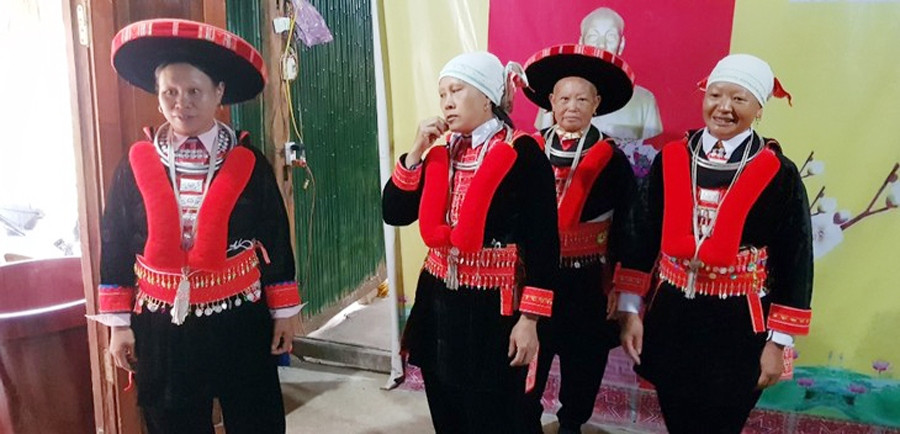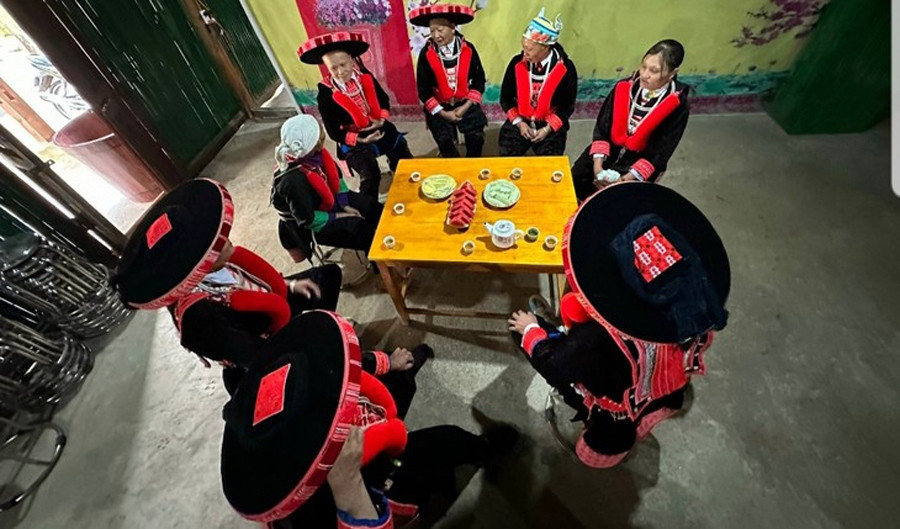

Red, the dominant colour of their clothes, distinguishes them from other groups. Men’s clothes, by contrast, are plainer and are mainly black and indigo.
The traditional costume of a Red Dao woman includes a headscarf, a shirt, a camisole, a belt, and a pair of pants. Silver buttons, necklaces, bracelets, earrings, and rings are also indispensable accessories.
Women’s clothes are embroidered and decorated with tassels of red, blue, yellow, white, and indigo, with red predominating. The Red Dao believe the red colour brings happiness, prosperity, and luck, and creates positive energy.
Hoang Thi Hong Vuong, a Red Dao woman in Phan Thanh commune, Nguyen Binh district, says that red is the representative colour of the Red Dao ethnic group and their indigo clothes are colorfully decorated with hand-embroidered motifs.
“A Red Dao woman wears a large hat and silver bracelets. Before getting married, a girl will make her own set of traditional clothes to wear on important occasions, including weddings, religious ceremonies, and New Year festivals,” said Vuong.
The most recognizable accessory of a Red Dao woman is her headscarf. The larger the headscarf, the better. The hem of the scarf is hand-embroidered with plant and flower motifs.
The shirt has a removable collar. It’s considered the most difficult item to make because it must satisfy strict aesthetic requirements. It has silver motifs attached and a red cotton sash that wraps around the neck and drapes in front of the shirt.
“It takes three days to make the neck piece because the buttons are so time-consuming,” said a Red Dao woman. “When a Dao girl gets married, the husband's family must make her a necklace, a bracelet, and silver buttons for her clothes.”

The costume making of the Red Dao in Vu Minh commune, Nguyen Binh district, was recognized in 2023 as a National Intangible Cultural Heritage by the Ministry of Culture, Sports, and Tourism.
Dispensing with the usual embroidery frame to flatten the cloth being embroidered, a Red Dao woman holds the piece of cloth in her hands. She doesn’t pre-draw the patterns, but freely embroiders from her imagination, creativity, and life experience.
“Young people have to make traditional costumes. Elderly people try to pass on the craft to young people to preserve our culture. We make our clothes by hand and beautify them with embroidery, fabric flowers, and beads,” says Ly Mui Sinh, a Red Dao woman in Phan Thanh commune.
While women’s costumes are elaborate, men’s clothes are quite plain and use only three colours – black, blue, and brown. A man wears a turban, shirt, and pants, as do the Tay, Nung, Lo Lo, and San Chi groups.
“The man wears a black shirt with four pockets and black pans. In the past the men used to wear 3, 5, or even 7 shirts at a time. The turban is also black or indigo. The buttons are made of cloth,” says Ban Duc Thang, deputy secretary of the Phan Thanh communal Party Committee and chairman of the communal People's Committee.
According to Red Dao belief, a woman’s traditional costume is buried with her so her ancestors can welcome her properly.
VOV